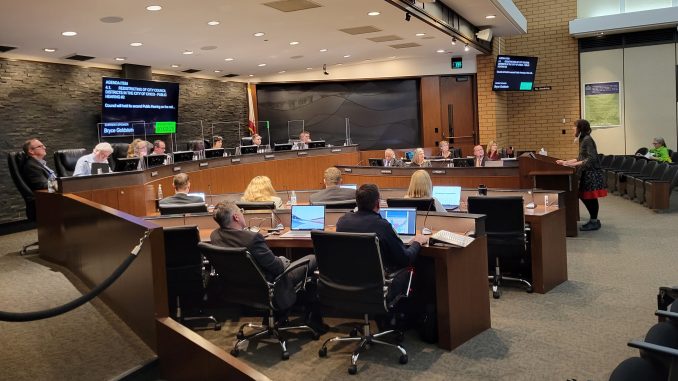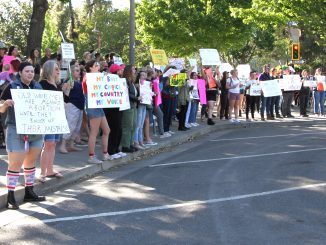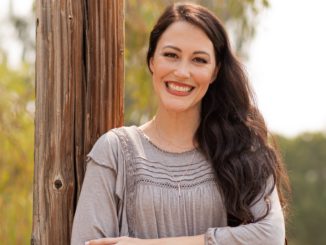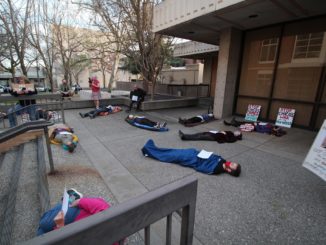
If absence makes the heart grow fonder, the Chico City Council might want to stick to Zoom. Moments of discord, ranging from snide asides to outright hostility, punctuated the return to City Council Chambers Tuesday evening (March 1) after three months of virtual meetings due to pandemic precautions. While council members kept their cool, multiple public speakers lashed out, including one who prompted Mayor Andrew Coolidge to gavel the business-from-the-floor comment session into a brief recess.
“There was a little tension,” Coolidge told the CN&R by phone Wednesday morning, “everybody adjusting to getting back in person … . But I think it went fine for our first meeting back. We didn’t have too many concerns.”
Ironically, the agenda item most ripe for contention—redistricting—wound up with consensus for now. The council advanced all 10 proposed maps to the next public hearing, at its March 15 meeting, with direction to demographer Claudio Gallegos to overlay neighborhoods that the members agreed should be considered as distinct units known as “communities of interest” (COI).
Gallegos, the city’s redistricting consultant with ARDA Demographics, had identified just one COI: California Park. However, Bryce Goldstein—a transportation planner and city planning commissioner who drew three of the seven maps submitted by the public—told the council she’d designated the Avenues, Barber, Chapman, south Chico and student neighborhoods.
Much of the discussion focused on minimizing division of the Avenues, which various proposals carve into three districts, and keeping Barber and Chapman each within a single district. The latter two neighborhoods currently fall within District 7, represented by Councilwoman Deepika Tandon.
“I’m actually looking forward to what the demographer will have to present [at the next meeting] depending on the requests today on keeping the communities of interest together, because that’s what I think our community wants here,” said Tandon, who took office in 2020 after the city’s first districted election. “I was definitely expecting those conversations. I was expecting more maps, too, but what we have is good and we’re trusting in the demographer to get us good, legal maps.”
Under the state’s FAIR MAPS Act, council districts may not vary in population by more than 10 percent. Along with the COI criteria, the city may create a district with a prevalence of a minority group’s voters, but Gallegos explained this is a “best practice” rather than a requirement. Seven of the proposals, including the three Gallegos drew, feature either District 4 or District 5 with at least 20 percent Latinos.
Gallegos has seven days to post online maps with COI overlays. Councilwoman Alex Brown requested the Avenues and student-density neighborhoods in one or two districts each, with single districts for Barber, Chapman, Cal Park and Meriam Park. Coolidge added Amber Grove, Lindo Channel and areas around Pleasant Valley High while specifying zones for student residences and Lower Bidwell Park.
“The obvious COIs are easy—the Avenues, Barber, Chapman, Cal Park, the student area, downtown—those are the ones everybody knows,” Coolidge, who represents District 5, told the CN&R. “I think it’s beneficial to consider outlying areas as well … . I would have liked to have seen more maps submitted, but obviously council can make changes to any of those maps.”
According to Gallegos, Chico is on track in terms of the process and public participation.
“I was fairly impressed with the community engagement,” he told the CN&R. “Oftentimes, you only get in many redistricting processes two, maybe three, people involved. So the fact that we had seven submissions is pretty good. [And] it is fairly normal for you to look at communities at interest to try and determine some of those boundaries—that’s one of the biggest factors you should be taking into account when creating these districts.”
Other items
On unanimous votes, the council approved a recommendation of its Internal Affairs Committee to fund a second access point into the Meyers Industrial Area and authorized Coolidge to sign a letter supporting Assembly Bill 2020 regarding mental-health conservatorships. Brown dissented on a 6-1 vote to discuss reconsidering the city’s Special Planning Areas (SPA) for development, which a 2020 decision had suspended pending updates of the general plan and housing element.
Two public speakers questioned the timing of the SPA action since the housing element will be updated over the next few months. The reconsideration stems from a request by Councilman Sean Morgan approved in December 2020, which City Clerk Debbie Presson explained had not made a subsequent agenda. She discovered the oversight during a recent review of city documents.
Other commenters took the council to task over transparency regarding the Warren v. City of Chico lawsuit (which council members continue to discuss in closed session) and Pallet shelter site contracts from the settlement, as well as the fence around City Plaza, which has remained more than a month since the ice rink closed. Another speaker railed against Councilman Michael O’Brien, then interrupted both Presson and Coolidge, leading the mayor to call for a recess.
City Manager Mark Orme told the council that the City Plaza fencing will come down over the next few weeks as maintenance crews complete work. He also reported on the ice rink, which he said drew around 20,000 paying guests and 45,000 “viewing visitors” despite heavy rain in December and early January. The venture brought in $347,000 and lost $28,000; sales tax figures are not in, but parking revenue was up 5 percent to 10 percent from pre-COVID winter 2019 numbers.




I was graveled after asking why the City Council did not reply to repeated E-mails sent them focusing on the FACT that Michael Thomas O’Brien DOESN’T belong on the City council because he failed to meet the requirements laid out on his application He was required to do the following
“THIS APPLICATION AND A STATEMENT OF ECONOMIC INTEREST (FORM 700) MUST BE SIGNED AND RETURNED BY THE SET DEADLINE” Form 700 was returned late thereby disqualifying O’Brien from serving on the council. ) Form verified as late by the FPPC site search for 700 forms. I had the proof with me and no reporter or Council member ask to see the proof. I disrupted the meeting by taking more than three minutes because an eye problem disrupted reading the proof aloud. The council believes that physical problems do not justify a slight overrun of time, but O’Brien failing to file his 700 form during the 30 days he had to file it is okay?
I resent your interpretation of what happened. You want the proof… just ask and don’t assume things. Filing the 700 form is a state requirement for assuming council office.